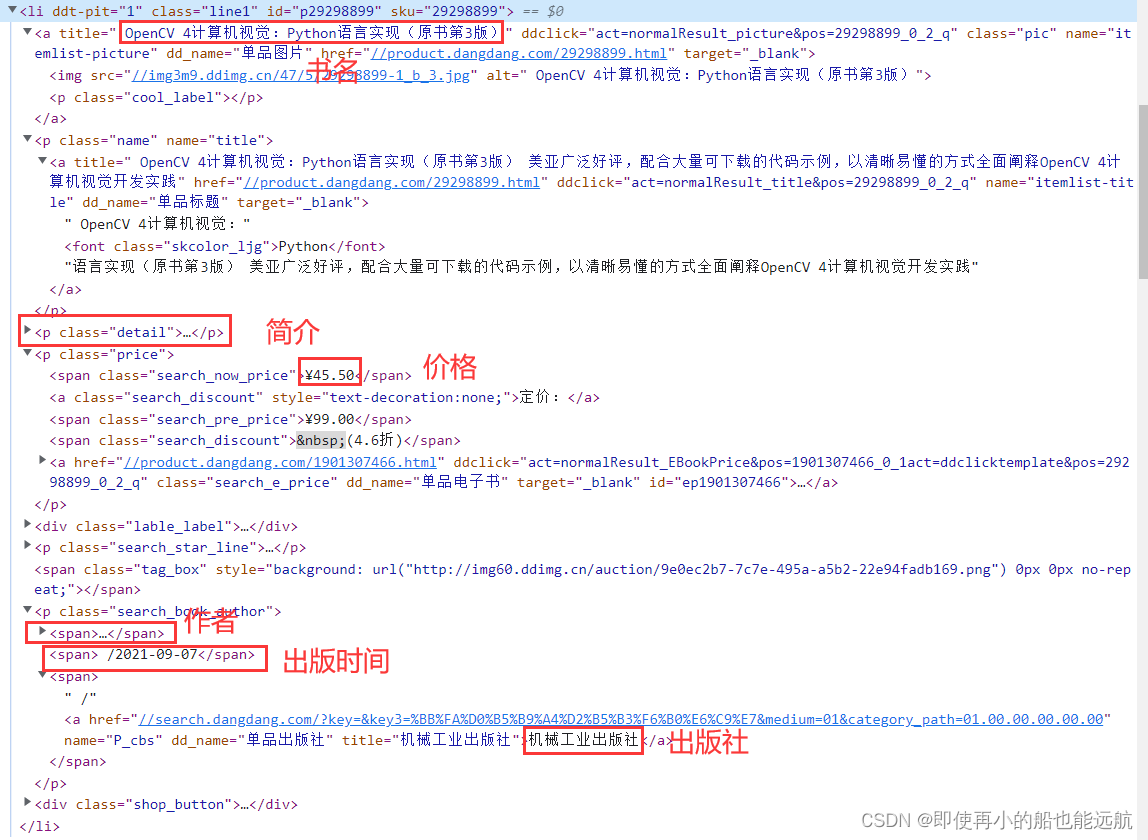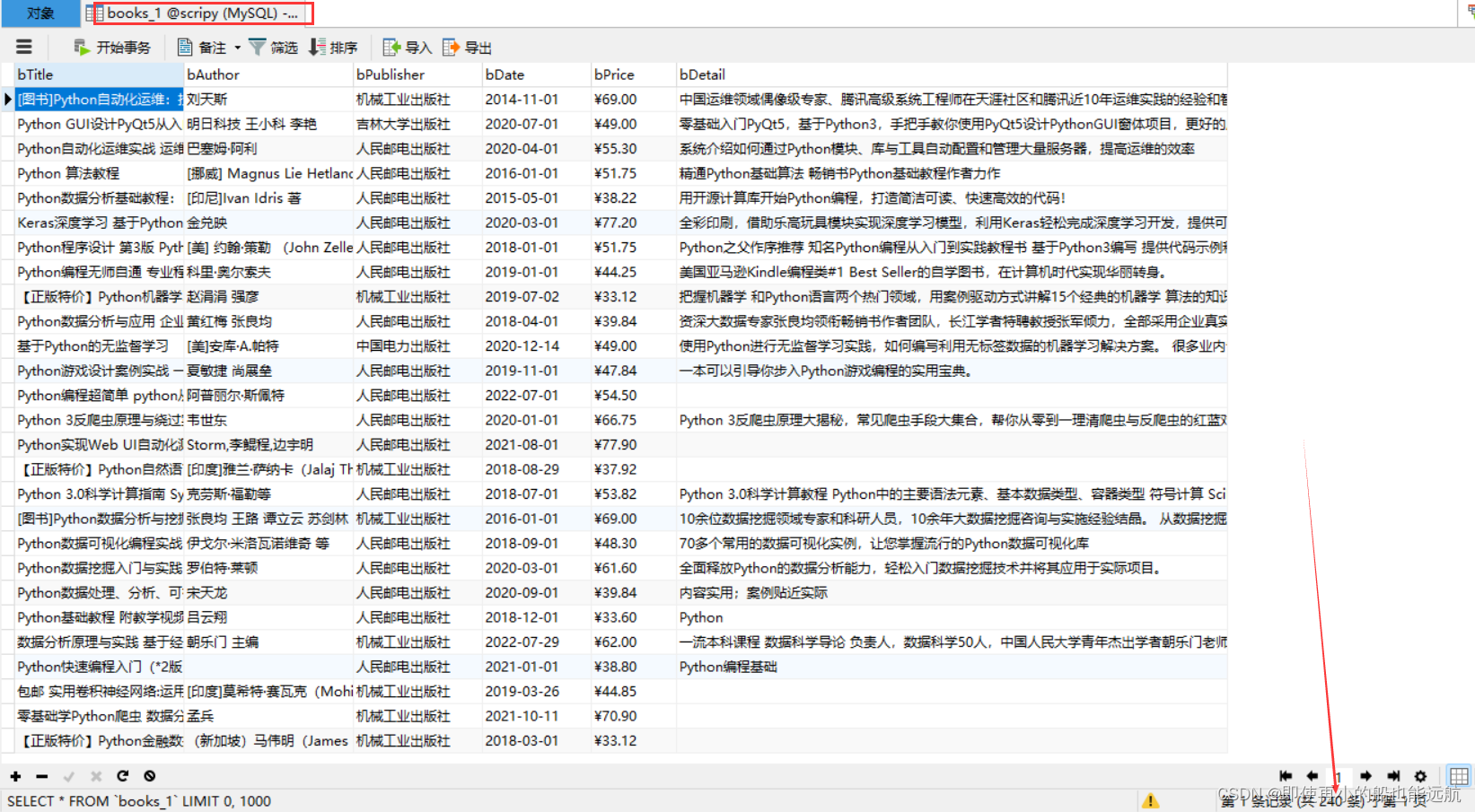实践****内容:Scrapy框架+Xpath信息提取方法设计商城(这里用的当当网)商品信息网站及爬虫程序,以关键字“书包”(python)搜索页面的商品,爬取(学号相关的特定某几个页面(最后一位,页面大于3)及限定数量商品(最后3位))商品信息。
编程思路:
1. 功能描述
- 输入:需要爬取的商品与学号
- 输出:书本信息并保存的MySQL中
2. 程序的结构设计
- 从当当网上获取数据:使用scripy框架,使用xpath查找html元素
- 下面两个特定数量爬取写了两个管道 pipelines_1.py, pipelines_2.py
- 爬取1:(最后一位,页面大于3)——>(3,>3)并输出到MySQL中,open_scripy,把数据INSERT到数据库中,close_scripy
- 爬取2:(最后3位)——>103条数据,并输出到MySQL,open_scripy,把数据INSERT到数据库中,close_scripy
1. 网站图书数据分析
当当图书网站是国内比较大型的图书网站,这个项目的目的就是对该网站的某个主题的一类图书的数据的爬取,把爬取的数据存储到MySQL数据库中。
例如我们关心Python类的图书,想知道网站上有什么Python的图书,用 Chrome浏览器进入当当网站,在搜索关键字中输入"Python"搜索得到 Python的图书,地址转为:
这类的图书很多,点击“下一页”后地址转为:
http://search.dangdang.com/?key=Python&act=input&page_index=2
从地址上我们知道知道搜索的关键字是key参数,页码参数是page_index, 而act=input参数只是表明是通过输入进行的查询。
网页元素分析,为后面使用Xpath查找做准备

仔细分析 HTML 代码结构,可以看到每本书都是一个<li>的项目,而且它们的结构完全是一样的,这些<li>包含在一个<ul>中。
在代码中选择第一个<li>,点击鼠标右键弹出菜单,执行"Edit as HTML" 进入文本编辑,复制出一本书<li>项目的代码,这段代码放到记事本中, 保存为book.txt文本文件时提示包含Unicode编码字符或者utf-16,于是按要求以 Unicode编码保存为book.txt文件。然后编写一小段程序用BeautifulSoup 装载:
BeautifulSoup 装载 Test1.py 如下:
# BeautifulSoup 装载
from bs4 import BeautifulSoup
fobj = open("book.txt", "rb")
data = fobj.read()
fobj.close()
data = data.decode("utf-16")
soup = BeautifulSoup(data, "lxml")
print(soup.prettify())
通过 **prettify **整理后就可以清晰看到
<html> <body></body> </html> 
精通Python基础算法 畅销书Python基础教程作者力作
¥51.75 定价: ¥69.00 (7.5折)
2. 网站图书数据提取
假定只关心图书的名称title、作者author、出版时间date、出版 社publisher、价格price以及书的内容简介detail,那么用book.txt存储的代码来测试获取的方法。从book.txt中的代码的分析,我们可以编写 test.py 程序获取这些数据.
图书数据获取 Test2.py 如下:
# 图书数据获取
from bs4 import BeautifulSoup
from bs4.dammit import UnicodeDammit
import scrapy
class TestItem:
def __init__(self):
self.title = ""
self.author = ""
self.date = ""
self.publisher = ""
self.price = ""
self.detail = ""
def show(self):
print(self.title)
print(self.author)
print(self.date)
print(self.price)
print(self.publisher)
print(self.detail)
try:
# 这段程序从book.txt中装载数据,并识别它的编码,生成Selector对象,并由此找到<li>元素节点。
fobj = open("book.txt", "rb")
data = fobj.read()
fobj.close()
dammit = UnicodeDammit(data, ["utf-8", "utf-16", "gbk"])
data = dammit.unicode_markup
selector = scrapy.Selector(text=data)
li = selector.xpath("//li")
# <li>中有多个<a>,从HTML代码可以看到书名包含在第一个<a>的title属性中,
# 因此通过position()=1找出第一个<a>,然后取出title属性值就是书名title。
title = li.xpath("./a[position()=1]/@title").extract_first()
# 价钱包含在<li>中的class='price'的<p>元素下面的 class='search_now_price'的<span>元素的文本中。
price = li.xpath("./p[@class='price']/span[@class='search_now_price']/text()").extract_first()
# 作者包含在<li>下面的class='search_book_author'的<p>元素下面的第一个
# <span>元素的title属性中,其中span[position()=1]就是限定第一个 <span>。
author = li.xpath("./p[@class='search_book_author']/span[position()=1]/a/@title").extract_first()
# 出版日期包含在<li>下面的class='search_book_author'的<p>元素下面的倒数第二个<span>元素的文本中,
# 其中span[position()=last()-1]就是限定倒数第二个 <span>,last()是最后一个<span>的序号。
date = li.xpath("./p[@class='search_book_author']/span[position()=last()-1] / text()").extract_first()
# 出版社包含在<li>下面的class='search_book_author'的<p>元素下面的最 后一个<span>元素的title属性中,
# 其中span[position()=last()]就是最后一 个 <span>,last()是最后一个<span>的序号。
publisher = li.xpath("./p[@class='search_book_author']/span[position()=last()]/a/@title").extract_first()
# 在<li>下面的class='detail'的<p>的文本就是书的简介。
detail = li.xpath("./p[@class='detail']/text()").extract_first()
item = TestItem()
# 无论是哪个数据存在, 那么extract_first()就返回这个数据的值,
# 如果不存在就返回None,为了避免出现None的值,我们把None转为空字符串。
item.title = title.strip() if title else ""
item.author = author.strip() if author else ""
# 从HTML中看到日期前面有一个符号"/",因此如果日期存在时就把这个前导的符号"/"去掉。
item.date = date.strip()[1:] if date else ""
item.publisher = publisher.strip() if publisher else ""
item.price = price.strip() if price else ""
item.detail = detail.strip() if detail else ""
item.show()
except Exception as err:
print(err)
程序执行结果:
Python 算法教程
[挪威] Magnus Lie Hetland 赫特兰
2016-01-01
¥51.75
人民邮电出版社
精通Python基础算法 畅销书Python基础教程作者力作
3. 网站图书数据爬取
(1)创建 MySQL 数据库
注意:下面创建数据库与数据表,已在 pipelines.py 中编写了
在 MySQL 中创建数据库 scripy, 创建2个图书表books如下:
CREATE DATABASE scripy;
CREATE TABLE books(
bTitle VARCHAR(512),
bAuthor VARCHAR(256),
bPublisher VARCHAR(256),
bDate VARCHAR(32),
bPrice VARCHAR(16),
bDetail text
);
(2)创建 scrapy 项目
scrapy startproject Project_books
(3)编写 items.py 中的数据项目类
# Define here the models for your scraped items
#
# See documentation in:
# https://docs.scrapy.org/en/latest/topics/items.html
import scrapy
class BookItem(scrapy.Item):
# define the fields for your item here like:
title = scrapy.Field()
author = scrapy.Field()
date = scrapy.Field()
publisher = scrapy.Field()
detail = scrapy.Field()
price = scrapy.Field()
(4)编写 pipelines_1.py 中的数据处理类
# Define your item pipelines here
#
# Don't forget to add your pipeline to the ITEM_PIPELINES setting
# See: https://docs.scrapy.org/en/latest/topics/item-pipeline.html
# useful for handling different item types with a single interface
import pymysql
class BookPipeline(object):
def open_spider(self, spider):
print("opened_爬取1")
try:
self.con = pymysql.connect(host="127.0.0.1", port=3306, user='root', password="123456", charset="utf8")
self.cursor = self.con.cursor(pymysql.cursors.DictCursor)
self.cursor.execute("CREATE DATABASE IF NOT EXISTS scripy")
self.con = pymysql.connect(host="127.0.0.1", port=3306, user='root', password="123456", db='scripy',
charset="utf8")
self.cursor = self.con.cursor(pymysql.cursors.DictCursor)
self.cursor.execute("CREATE TABLE IF NOT EXISTS books_1("
"bTitle VARCHAR(512),"
"bAuthor VARCHAR(256),"
"bPublisher VARCHAR(256),"
"bDate VARCHAR(32),"
"bPrice VARCHAR(16),"
"bDetail text)")
self.cursor.execute("DELETE FROM books_1")
self.opened = True
self.count_1 = 0
except Exception as err:
print(err)
self.opened = False
def close_spider(self, spider):
if self.opened:
self.con.commit()
self.con.close()
self.opened = False
print("closed_爬取1")
print(f"总共爬取{self.count_1}本书籍")
def process_item(self, item, spider):
try:
print(item["title"])
print(item["author"])
print(item["publisher"])
print(item["date"])
print(item["price"])
print(item["detail"])
print()
if self.opened:
self.cursor.execute("INSERT INTO books_1(bTitle,bAuthor,bPublisher,bDate,bPrice,bDetail)"
"value (%s,%s,%s,%s,%s,%s)",
(item["title"], item["author"], item["publisher"],
item["date"], item["price"], item["detail"]))
self.count_1 += 1
except Exception as err:
print(err)
# spider.crawler.engine.close_spider(spider, "无有效信息,关闭spider") # pepline 中使用此关闭方法
return item
(5)编写 pipelines_2.py 中的数据处理类
# Define your item pipelines here
#
# Don't forget to add your pipeline to the ITEM_PIPELINES setting
# See: https://docs.scrapy.org/en/latest/topics/item-pipeline.html
# useful for handling different item types with a single interface
import pymysql
class Input_message:
key = input('请输入需要爬取当当网的某类书籍:')
id = input("请输入学号:") # 102002103
page = id[-1] # 爬取1-->第3页开始,爬取大于3页结束
page_1 = int(input(f"从第{page}开始,爬取__页(请大于3页):"))
num = id[-3:] # 爬取2-->103件商品
class BookPipeline(object):
def open_spider(self, spider):
print("opened_爬取2")
try:
self.con = pymysql.connect(host="127.0.0.1", port=3306, user='root', password="123456", charset="utf8")
self.cursor = self.con.cursor(pymysql.cursors.DictCursor)
self.cursor.execute("CREATE DATABASE IF NOT EXISTS scripy")
self.con = pymysql.connect(host="127.0.0.1", port=3306, user='root', password="123456", db='scripy',
charset="utf8")
self.cursor = self.con.cursor(pymysql.cursors.DictCursor)
self.cursor.execute("CREATE TABLE IF NOT EXISTS books_2("
"bTitle VARCHAR(512),"
"bAuthor VARCHAR(256),"
"bPublisher VARCHAR(256),"
"bDate VARCHAR(32),"
"bPrice VARCHAR(16),"
"bDetail text)")
self.cursor.execute("DELETE FROM books_2")
self.opened = True
self.count_2 = 0
except Exception as err:
print(err)
self.opened = False
def close_spider(self, spider):
if self.opened:
self.con.commit()
self.con.close()
self.opened = False
print("closed_爬取2")
print(f"总共爬取{self.count_2}本书籍")
def process_item(self, item, spider):
try:
print(item["title"])
print(item["author"])
print(item["publisher"])
print(item["date"])
print(item["price"])
print(item["detail"])
print()
if self.opened:
self.cursor.execute("INSERT INTO books_2(bTitle,bAuthor,bPublisher,bDate,bPrice,bDetail)"
"value (%s,%s,%s,%s,%s,%s)",
(item["title"], item["author"], item["publisher"],
item["date"], item["price"], item["detail"]))
self.count_2 += 1
if self.count_2 == int(Input_message.num): # 学号后3为
BookPipeline.close_spider(self, spider)
except Exception as err:
print(err)
# spider.crawler.engine.close_spider(spider, "无有效信息,关闭spider") # pepline 中使用此关闭方法
return item
在scrapy的过程中一旦打开一个 spider 爬虫, 就会执行这个类的 open_spider(self,spider) 函数,一旦这个 spider 爬虫关闭, 就执行这个类的 close_spider(self,spider) 函数。因此程序在open_spider 函数中**连接 MySQL数据库,并创建操作游标 self.cursor**,在close_spider中提交数 据库并关闭数据库,程序中使用 count 变量统计爬取的书籍数量。 在数据处理函数中每次有数据到达,就显示数据内容,并使用 insert 的SQL语句把数据插入到数据库中。
(6)编写 Scrapy 的配置文件settings.py
ITEM_PIPELINES = {
"Project_books.pipelines_1.BookPipeline": 300,
"Project_books.pipelines_2.BookPipeline": 300,
}
简单的配置 settings,这样就可以把爬取的数据推送到管道的BookPipeline类中。
(7)编写 Scrapy 爬虫程序MySpider.py
import scrapy
from ..items import BookItem
from bs4.dammit import UnicodeDammit
from ..pipelines_2 import Input_message
class MySpider(scrapy.Spider):
name = "mySpider"
source_url = "https://search.dangdang.com/"
act = '&act=input&page_index='
# 以下信息写道pipelines2里了
# id = input("请输入学号:") # 102002103
# page = id[-1] # 爬取1-->第3页开始,爬取大于3页结束
# page_1 = int(input(f"从第{page}开始,爬取__页(请大于3页):"))
# num = id[-3:] # 爬取2-->103件商品
# 指明要爬取的网址
def start_requests(self):
# url = 'http://search.dangdang.com/?key=Python&act=input&page_index=2'
url = MySpider.source_url + "?key=" + Input_message.key + MySpider.act + Input_message.page
yield scrapy.Request(url=url, callback=self.parse)
# 回调函数
def parse(self, response, **kwargs):
try:
dammit = UnicodeDammit(response.body, ["utf-8", "gbk"])
data = dammit.unicode_markup
selector = scrapy.Selector(text=data)
lis = selector.xpath("//li['@ddt-pit'][starts-with(@class,'line')]")
for li in lis:
title = li.xpath("./a[position()=1]/@title").extract_first()
price = li.xpath("./p[@class='price']/span[@class='search_now_price']/text()").extract_first()
author = li.xpath("./p[@class='search_book_author']/span[position()=1]/a/@title").extract_first()
date = li.xpath("./p[@class='search_book_author']/span[position()=last()-1]/text()").extract_first()
publisher = li.xpath(
"./p[@class='search_book_author']/span[position()=last()]/a/@title").extract_first()
detail = li.xpath("./p[@class='detail']/text()").extract_first()
# detail 有时没有,结果None
item = BookItem()
item["title"] = title.strip() if title else ""
item["author"] = author.strip() if author else ""
item["date"] = date.strip()[1:] if date else ""
item["publisher"] = publisher.strip() if publisher else ""
item["price"] = price.strip() if price else ""
item["detail"] = detail.strip() if detail else ""
yield item
# 最后一页时 link 为None
# 1.连续爬取不同的页
# link = selector.xpath("//div[@class='paging']/ul[@name='Fy']/li[@class='next']/a/@href").extract_first()
# if link:
# url = response.urljoin(link)
# yield scrapy.Request(url=url, callback=self.parse)
# 2.翻页(学号最后一位+1,学号最后一位+input > 3)
for i in range(int(Input_message.page) + 1, int(Input_message.page) + Input_message.page_1):
url = MySpider.source_url + "?key=" + Input_message.key + MySpider.act + str(i)
yield scrapy.Request(url, callback=self.parse)
except Exception as err:
print(err)
分析网站的HTML代码发现在一个 <div class='paging'> 的元素中包含了翻页的 信息,<div>下面的 <ul name='Fy'> 下面的 <li class='next'> 下面的 <a> 链接就是 下一页的链接,取出这个链接地址,通过 response.urljoin 函数整理成绝对地址,再次产生一个scrapy.Request对象请求,回调函数仍然为这个parse函数,这样就可以 递归调用parse函数,实现下一个网页的数据爬取。爬取到最后一页时,下一页的链接为空,link=None就不再递归调用了。
(8)执行 Scrapy 爬虫程序run.py
from scrapy import cmdline
cmdline.execute("scrapy crawl mySpider -s LOG_ENABLED=False".split())
执行这个程序就可以爬取到所有关于 xxx 的书籍,这些书籍的数据存储到MySQL的scripy数据库中,执行完毕后在MySQL中可以看到爬取的结果,产生了两张表,对应不同的数量要求。
控制台结果如下:


** 数据库结果如下:**


总结:
scrapy把数据爬取与数据存储分开处理,它们都是异步执行的, MySpider每爬取到一个数据项目item,就yield推送给pipelines.py 程序存储,等待存储完毕后又再次爬取另外一个数据项目item,再次yield推送到pipelines.py程序,然后再次存储,......,这个过程一 直进行下去,直到爬取过程结束,文件books.txt中就存储了所有的 爬取数据了。
恭喜你成功突破第四章!人生不可能一帆风顺,逆境中更要坚定信念!
下一篇文章:5.1 商城网站项目背景与目标
实战源码:Python网络爬虫实战
版权归原作者 即使再小的船也能远航 所有, 如有侵权,请联系我们删除。
